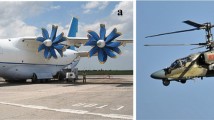Abstract
The present study explores the aerodynamic parameter analysis and design of a quad-rotor air vehicle in hover using Computational fluid dynamics (CFD) and Design of experiments (DOE). Following the identification of the center distance between rotors in terms of hovering thrust and velocity/pressure distributions, the blade-shape parameter design is implemented to predict the optimal levels of twist angle, maximum chord position, blade cross-section type and twist position, and the significant factor effects and factor interactions in DOE are discussed. The present study shows that optimized twist angle and twist-starting position enables maximum hovering thrust in the proposed quad-copter.
Similar content being viewed by others
References
A. R. Girard, A. S. Howell and J. K. Hedrick, Border patrol and surveillance missions using multiple unmanned air vehicles, Proceedings of the 43rd IEEE Conference on Decision and Control, 1 (2004) 620–625.
A. Le Pape and P. Beaumier, Numerical optimization of helicopter rotor aerodynamic performance in hover, Aerospace Science and Technology, 9 (3) (2005) 191–201.
J. H. Yun, H.-Y. Choi and J. Lee, CFD-based thrust analysis of unmanned aerial vehicle in hover mode: Effects of single rotor blade shape, Transactions of the Korean Society of Mechanical Engineers A, 38 (5) (2014) 513–520.
P. Pounds, R. Mahony, J. Gresham, P. Corke and J. Roberts, Towards dynamically-favourable quad-rotor aerial robots, Proceedings of the 2004 Australasian Conference on Robotics & Automation, Canberra, Australia, April (2004).
H. Huang, G. M. Hoffmann, S. L. Waslander and C. J. Tomlin, Aerodynamics and control of autonomous quadrotor helicopters in aggressive maneuvering, Proceedings of International Conference on Robotics and Automation 2009, Kobe, Japan, May (2009) 3277–3282.
E. Çetinsoy, S. Dikyar, C. Hançer, K. T. Oner, E. Sirimoglu, M. Unel and M. F. Aksit, Design and construction of a novel quad tilt-wing UAV, Mechatronics, 22 (6) (2012) 723–745.
S. U. Islam, C. Y. Zhou and F. Ahmad, Numerical simulations of cross-flow around four square cylinders in an in-line rectangular configuration, World Academy of Sciences, Engineering Technology, 33 (2009) 824–833.
D. Aleksandrov and I. Penkov, Optimization of lift force of mini quad rotor helicopter by changing of distance size between rotors, Solid State Phenomena, 198 (2013) 226–231.
Y. Naidoo, R. Stopforth and G. Bright, Quad-rotor unmanned aerial vehicle helicopter modelling & control, International Journal of Advanced Robotic System, 8 (4) (2011) 139–149.
P. C. Trizaila, Aerodynamics of low Reynolds number rigid flapping wing under hover and free-stream conditions, Ph.D. Dissertation, Department of Aerospace Engineering, The University of Michigan (2011).
V. K. Lakshminarayan and J. D. Baeder, Computational investigation of micro hovering rotor aerodynamics, Journal of the American Helicopter Society, 55 (2) (2010) 22001.
ANSYS FLUENT 14.5 Help, ANSYS, INC., Canonsburg, PA (2013).
T. H. Kim, S. J. An, Y. D. Jo, K. M. Moon, B. Y. Bae and D. H. Yang, A study on the composite blade performance variation by attaching erosion shield for hovercraft, Journal of the Korean Society of Marine Engineering, 33 (7) 1017–1025.
R. Steij and G. Barakos, CFD analysis of rotor-fuselage interactional aerodynamics, Proceedings of the 45th AIAA Aerospace Sciences Meeting and Exhibit, Reno, NV, January (2007).
M. H. Mohamed, A. M. Ali and A. A. Hafiz, CFD analysis for H-rotor darrieus turbine as a low speed wind energy converter, International Journal of Engineering Science and Technology, 18 (1) (2014) 1–13.
S. W. Lee and O. J. Kwon, Aerodynamic shape optimization of hovering rotor blades in transonic flow using unstructured meshes, AIAA Journal, 44 (8) (2006) 1816–1825.
W. Y. Fowlkes and C. M. Creveling, Engineering methods for robust product design, Addison Wesley, Reading, MA (1995).
Author information
Authors and Affiliations
Corresponding author
Additional information
Recommended by Associate Editor Chang-Wan Kim
Jongsoo Lee received B.S. in Mechanical Engineering at Yonsei University, Korea in 1988 and Ph.D. in Mechanical Engineering at Rensselaer Polytechnic Institute, Troy, NY in 1996. After a Research Associate at Rensselaer Rotorcraft Technology Center, he is a Professor of Mechanical Engineering at Yonsei University. His research interests include multidisciplinary/ multi-physics/multi-scale design optimization and reliability-based robust engineering design with applications to structures, structural dynamics, fluid-structure interactions and flow induced noise and vibration problems.
Jaehyun Yoon is a Ph.D. student in Mechanical Engineering at Yonsei University. His research interests are on the Aerodynamics, Dynamics, Control and Optimization in Robust Design of Multi-Rotor Air Vehicles.
Rights and permissions
About this article
Cite this article
Yoon, J., Lee, J. Parameter analysis and design for the hovering thrust of a quad-rotor air vehicle using CFD and design of experiment. J Mech Sci Technol 32, 781–791 (2018). https://doi.org/10.1007/s12206-018-0126-0
Received:
Revised:
Accepted:
Published:
Issue Date:
DOI: https://doi.org/10.1007/s12206-018-0126-0




